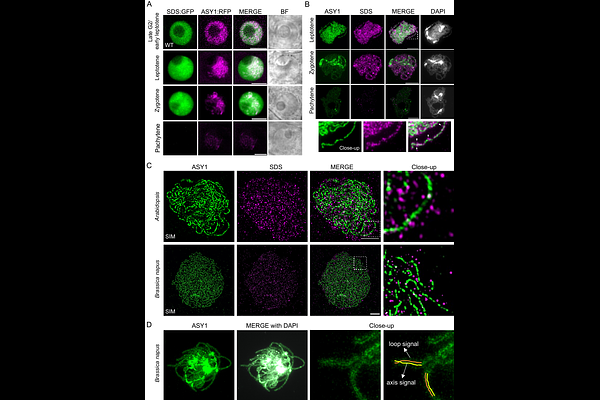The HORMA-domain protein ASY1 recruits the plant-specific cyclin SDS to promote DMC1-mediated meiotic recombination

The HORMA-domain protein ASY1 recruits the plant-specific cyclin SDS to promote DMC1-mediated meiotic recombination
Cai, B.; Yuan, X.; Luo, Y.; Cao, F.; Zhang, Y.; Zhuang, J.; Geng, M.; Chu, L.; Schnittger, A.; Yang, C.
AbstractThe chromosome axis is a proteinaceous scaffold essential for crossover formation in meiosis. While the axis associated HORMA-domain protein ASY1 is known to be necessary for the localization of the recombinase DMC1 to the axis, the molecular mechanism linking ASY1 to DMC1 loading remains unclear. Here, we demonstrate that ASY1 directly recruits the plant-specific cyclin SDS to chromosomes, which ensures efficient DMC1 localization and interhomolog recombination. Live-cell imaging and immunodetection revealed that SDS localizes to chromosomes from leptotene to zygotene and dissociates from chromosomes after pachytene resembling DMC1 dynamics. Biochemical assays demonstrated a direct interaction between ASY1 and SDS. Further analyses revealed that ASY1 closure motif, a conformational regulatory element, is required for SDS recruitment despite being dispensable for ASY1 own chromosome association. Moreover, unlike in sds mutants, depletion of the DMC1 inhibitor FIGL1-FLIP complex failed to restore DMC1 foci in asy1 mutants, positioning ASY1 upstream of both positive (SDS) and negative (FIGL1-FLIP) regulators of DMC1. These findings establish ASY1 as a key coordinator of meiotic recombination, bridging chromosome axis architecture with recombinase dynamics to control crossover formation and genome stability.